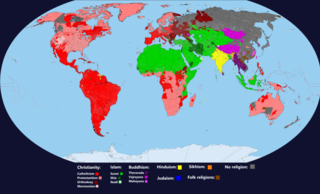Fiqh is Islamic jurisprudence. Fiqh is often described as the human understanding and practices of the sharia, that is human understanding of the divine Islamic law as revealed in the Quran and the sunnah. Fiqh expands and develops Shariah through interpretation (ijtihad) of the Quran and Sunnah by Islamic jurists (ulama) and is implemented by the rulings (fatwa) of jurists on questions presented to them. Thus, whereas sharia is considered immutable and infallible by Muslims, fiqh is considered fallible and changeable. Fiqh deals with the observance of rituals, morals and social legislation in Islam as well as economic and political system. In the modern era, there are four prominent schools (madh'hab) of fiqh within Sunni practice, plus two within Shi'a practice. A person trained in fiqh is known as a faqīh.
Shia Islam is the second-largest branch of Islam. It holds that the Islamic prophet Muhammad designated Ali ibn Abi Talib as his successor (khalīfa) and the Imam after him, at the event of Ghadir Khumm, but was prevented from succeeding Muhammad as leader of the Muslims by some of Muhammad's other companions (ṣaḥāba) at Saqifah. This view contrasts with Sunnī Islam, which asserts that Muhammad did not appoint a successor before his death and considers Abū Bakr, who was appointed caliph by a group of senior Muslims at Saqifah, to be the first rightful (rāshidūn) caliph after Muhammad. Adherents of Shia Islam are called Shia Muslims.

A religious denomination is a subgroup within a religion that operates under a common name and tradition, among other activities. The term refers to the various Christian denominations. It is also used to describe the five major branches of Judaism. Within Islam, it can refer to the branches or sects, as well as their various subdivisions, such as sub-sects, schools of jurisprudence, schools of theology and religious movements.
The Hanbali school or Hanbalism is one of the four major schools of Islamic jurisprudence within Sunni Islam. It is named after and based on the teachings of the 9th-century scholar, jurist and traditionist Ahmad ibn Hanbal, and later institutionalized by his students. It is the smallest and most strictly traditionalist of the four major Sunni schools, the others being the Hanafi, Maliki and Shafi'i schools.
The Maliki school or Malikism is one of the four major schools of Islamic jurisprudence within Sunni Islam. It was founded by Malik ibn Anas in the 8th century. The Maliki school of jurisprudence relies on the Quran and hadiths as primary sources. Unlike other Islamic fiqhs, Maliki fiqh also considers the consensus of the people of Medina to be a valid source of Islamic law.
A madhhab refers to any school of thought within Islamic jurisprudence.
In Islamic jurisprudence, qiyas is the process of deductive analogy in which the teachings of the hadith are compared and contrasted with those of the Quran, in order to apply a known injunction (nass) to a new circumstance and create a new injunction. Here the ruling of the sunnah and the Quran may be used as a means to solve or provide a response to a new problem that may arise. This, however, is only the case providing that the set precedent or paradigm and the new problem that has come about will share operative causes. The ʿillah is the specific set of circumstances that trigger a certain law into action. An example of the use of qiyās is the case of the ban on selling or buying of goods after the last call for Friday prayers until the end of the prayer stated in the Quran 62:9. By analogy this prohibition is extended to other transactions and activities such as agricultural work and administration. Among Sunni Muslims, Qiyas has been accepted as a secondary source of Sharia law along with Ijmāʿ, after the primary sources of the Quran, and the Sunnah.
Islam is the majority and state religion in Algeria. The vast majority of citizens are Sunni Muslims belonging to Maliki school of jurisprudence, with a minority of Ibadi Muslims, most of whom live in the M'zab Valley region. Islam provides the society with its central social and cultural identity and gives most individuals their basic ethical and attitudinal orientation. Orthodox observance of the faith is much less widespread and steadfast than is identification with Islam. There are also Sufi philosophies which arose as a reaction to theoretical perspectives of some scholars.
ʾUṣūl al-fiqh or Principles of Islamic jurisprudence are traditional methodological principles used in Islamic jurisprudence (fiqh) for deriving the rulings of Islamic law (sharia).

Islamic schools and branches have different understandings of Islam. There are many different sects or denominations, schools of Islamic jurisprudence, and schools of Islamic theology, or ʿaqīdah (creed). Within Islamic groups themselves there may be differences, such as different orders (tariqa) within Sufism, and within Sunnī Islam different schools of theology and jurisprudence. Groups in Islam may be numerous, or relatively small in size.
The Jaʿfarī school, also known as the Jafarite school, Jaʿfarī fiqh or Ja'fari jurisprudence, is a prominent school of jurisprudence (fiqh) within Twelver and Ismaili Shia Islam, named after the sixth Imam, Ja'far al-Sadiq. In Iran, Jaʽfari jurisprudence is enshrined in the constitution, shaping various aspects of governance, legislation, and judiciary in the country.
Ahl al-Ḥadīth is an Islamic school of Sunni Islam that emerged during the 2nd and 3rd Islamic centuries of the Islamic era as a movement of hadith scholars who considered the Quran and authentic hadith to be the only authority in matters of law and creed. They were known as "Athari" for championing traditionalist theological doctrines which rejected rationalist approaches and advocated a strictly literalist reading of Scriptures. Its adherents have also been referred to as traditionalists and sometimes traditionists. The traditionalists constituted the most authoritative and dominant bloc of Sunni orthodoxy prior to the emergence of mad'habs during the fourth Islamic century.

Islam is the largest religion in Morocco, with more than 99% of the population adhering to it. The largest subset of Muslims in Morocco are Maliki Sunni; other numerous groups include practitioners of Zahirism and non-denominational Muslims. Islam is the nation's state religion. Blasphemy against Islam is a punishable offense.

Various sociological classifications of religious movements have been proposed by scholars. In the sociology of religion, the most widely used classification is the church-sect typology. The typology is differently construed by different sociologists, and various distinctive features have been proposed to characterise churches and sects. On most accounts, the following features are deemed relevant:
The Amman Message is a statement calling for tolerance and unity in the Muslim world that was issued on 9 November 2004 by King Abdullah II bin Al-Hussein of Jordan, and his advisor Sheikh Izz-Eddine Al-Tamimi. The message aims to "clarify to the modern world the true nature of Islam and the nature of true Islam," and to specify which actions do and do not represent the religion.
Dāwūd ibn ʿAlī ibn Khalaf al-Ẓāhirī was a Sunni Muslim scholar, jurist, and theologian during the Islamic Golden Age, specialized in the study of Islamic law (sharīʿa) and the fields of hermeneutics, biographical evaluation, and historiography of early Islam. He is widely regarded as the founder of the Ẓāhirī school of thought (madhhab), the fifth school of thought in Sunnī Islam, characterized by its strict adherence to literalism and reliance on the outward (ẓāhir) meaning of expressions in the Quran and ḥadīth literature; the consensus (ijmāʿ) of the first generation of Muhammad's closest companions (ṣaḥāba), for sources of Islamic law (sharīʿa); and rejection of analogical deduction (qiyās) and societal custom or knowledge (urf), used by other schools of Islamic jurisprudence. He was a celebrated, if not controversial, figure during his time, being referred to in Islamic historiographical texts as "the scholar of the era."
Non-denominational Muslims are Muslims who do not belong to, do not self-identify with, or cannot be readily classified under one of the identifiable Islamic schools and branches. Such Muslims do not think of themselves as belonging to a denomination but rather as "just Muslims" or "non-denominational Muslims."

Schools of Islamic theology are various Islamic schools and branches in different schools of thought regarding creed. The main schools of Islamic theology include the extant Mu'tazili, Ash'ari, Maturidi, and Athari schools; the extinct ones include the Qadari, Jahmi, Murji', and Batini schools.
The Ẓāhirī school or Zahirism is a Sunnī school of Islamic jurisprudence founded in the 9th century by Dāwūd al-Ẓāhirī, a Muslim scholar, jurist, and theologian of the Islamic Golden Age. It is characterized by strict adherence to literalism and reliance on the outward (ẓāhir) meaning of expressions in the Quran and ḥadīth literature; the consensus (ijmāʿ) of the first generation of Muhammad's closest companions (ṣaḥāba), for sources of Islamic law (sharīʿa); and rejection of analogical deduction (qiyās) and societal custom or knowledge (urf), used by other schools of Islamic jurisprudence.

Shia Islam in Yemen is practiced by a substantial minority of the population, with the vast majority of Shia Muslims in Yemen being Zaydi, while a minority are Twelver and Isma'ili. Sunni Muslims make up 65% percent of Yemen, while 35% of the country are Shia Muslims. These Shia Muslims are predominantly concentrated in the northwestern regions of the country, including the capital and major cities that are some of the most densely populated areas of Yemen.











